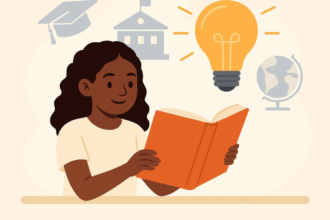Introduction to Gen Z and their relationship with technology
Generation Z is redefining the way we think about education. Born into a world dominated by technology, this digital-savvy group has seamlessly integrated online learning into their daily lives. Traditional classrooms are no longer the sole source of knowledge; instead, social media platforms have emerged as vibrant hubs for acquiring skills and information. With platforms like YouTube and TikTok leading the charge, Gen Z is harnessing these tools to thrive academically and professionally. As they navigate this dynamic landscape, it’s fascinating to see how their approach to learning differs from previous generations. Let’s dive deeper into how Gen Z is reshaping education in our tech-driven era!
The rise of YouTube as a learning platform for Gen Z
YouTube has transformed into a powerhouse for Gen Z’s learning journey. This generation thrives on visual content and instant access, making YouTube the ideal platform.
With millions of educational channels available, there’s something for everyone. From DIY tutorials to complex science experiments, learners can explore diverse subjects at their own pace.
Creators like Khan Academy and CrashCourse have made it easier than ever to grasp difficult concepts with engaging visuals and relatable explanations.
The interactive nature of comments allows viewers to ask questions or share insights. This community aspect enriches the learning experience further.
Moreover, YouTube is accessible anywhere—whether on a smartphone during a commute or on a laptop in a cozy corner. It removes barriers often found in traditional classrooms.
Gen Z isn’t just passive consumers; they are active participants in their education through playlists tailored to their interests and goals.
The emergence of TikTok as a popular educational tool
TikTok has taken the world by storm, and its impact on education is undeniable. With bite-sized videos that capture attention quickly, it’s becoming a go-to resource for Gen Z learning online.
Educators and students alike are harnessing the platform to share knowledge in creative ways. From science experiments to language lessons, TikTok transforms complex topics into engaging snippets.
Hashtags like #LearnOnTikTok have made educational content easily discoverable. Users can find everything from math tricks to historical facts at lightning speed.
The appeal lies in its entertainment value. Short-form content keeps viewers engaged while they absorb information effortlessly. This format resonates with younger audiences who thrive on instant gratification.
As trends evolve, more educators are using this platform as an innovative tool for teaching and connecting with their students outside traditional classroom settings. TikTok is redefining how academic concepts come alive in the digital age.
How Gen Z is using social media for academic and career development
Gen Z is transforming the way they approach academic and career development through social media. Platforms like LinkedIn, Instagram, and TikTok are becoming essential tools for networking and learning.
On LinkedIn, they build professional profiles that showcase skills and experiences. Many use it to connect with industry leaders or find internships. This direct line to professionals can lead to opportunities previously inaccessible.
Instagram serves as a visual portfolio. Creative students share projects or artwork, attracting potential employers who appreciate innovation. Short videos explaining concepts also help peers grasp difficult subjects.
TikTok stands out for its bite-sized educational content. Users create engaging clips on topics ranging from science experiments to coding tips. The platform’s viral nature allows knowledge sharing in an entertaining format.
As these digital platforms evolve, Gen Z continues to harness them for growth in academia and future careers.
Advantages and disadvantages of learning through social media platforms
Learning through social media platforms offers several advantages. Accessibility stands out as a key benefit. With just a smartphone, users can access vast amounts of information anytime and anywhere.
Engagement is another strong point. Platforms like TikTok and Instagram promote interactive learning experiences, making education more entertaining and relatable for Gen Z.
However, there are downsides to consider. The abundance of content can lead to misinformation. Users may struggle to differentiate between credible sources and unreliable ones.
Distractions abound in the social media environment too. Notifications and entertainment options may derail focused study sessions, causing learners to lose track of their academic goals.
Moreover, not all content is structured or thorough enough for deep understanding. While bite-sized lessons are appealing, they might lack the depth needed for complex subjects. Balancing these factors is essential for effective online learning experiences among Gen Z.
The impact of online learning on traditional education systems
Online learning is reshaping traditional education systems in profound ways. With platforms like YouTube and TikTok, educational content is more accessible than ever. Students can learn at their own pace, diving into topics that intrigue them.
This shift challenges the conventional classroom model. Traditional educators must adapt to a world where students often have access to diverse perspectives online. The one-size-fits-all approach is losing its effectiveness as personalized learning becomes more prominent.
Moreover, teachers are now competing with engaging social media content that captures attention quickly. This raises questions about how traditional institutions can innovate their teaching methods to stay relevant.
Schools are also exploring hybrid models that blend digital resources with face-to-face instruction. This integration could enhance the overall learning experience by combining structure with flexibility. As online platforms continue to influence Gen Z’s educational preferences, the landscape of schooling will likely evolve dramatically in years ahead.
The future of online learning for Gen Z
As Gen Z continues to reshape the landscape of education, the future of online learning promises to be more interactive and personalized. With advancements in AI and machine learning, educational tools will adapt to individual needs, offering tailored content that resonates with each learner.
Virtual reality (VR) and augmented reality (AR) are poised to revolutionize how lessons are delivered. Imagine stepping into a historical event or exploring a scientific concept through immersive experiences. This type of engagement keeps students invested in their learning journey.
Additionally, social media platforms are set to evolve further as hubs for knowledge exchange. Short tutorials on TikTok could transform into comprehensive mini-courses, catering precisely to Gen Z’s desire for quick yet substantial information.
Collaboration among peers will thrive in this digital environment too. Online study groups can connect learners worldwide, breaking down geographical barriers and fostering diverse perspectives on various subjects.
Conclusion – embracing the changing landscape of education
The landscape of education is shifting dramatically as digital platforms become integral to the learning process. Gen Z, with their inherent fluency in technology, embraces these changes wholeheartedly. They navigate between YouTube tutorials and TikTok challenges, transforming traditional concepts into engaging snippets.
Social media in education 2025 promises even more innovation. As platforms evolve and new tools emerge, Generation Z will continue to redefine how knowledge is acquired and shared. The rise of digital learning for this generation underscores a significant shift toward personalized education experiences that cater to diverse needs.
While there are certainly challenges—such as misinformation or distraction—the advantages can’t be overlooked. Accessibility and varied teaching methods empower students like never before. By adapting their approach, educators can harness these trends rather than resist them.
As we move forward, it’s essential for institutions to recognize this dynamic relationship between technology and learning. Fostering an environment where curiosity thrives will ensure that both educators and learners flourish together in this exciting era of online education.










